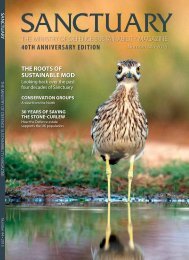SUSTAINABILITY
UBUt5
UBUt5
Create successful ePaper yourself
Turn your PDF publications into a flip-book with our unique Google optimized e-Paper software.
AROUND THE REGIONS<br />
16<br />
Northamptonshire<br />
Yardley Chase Training Area<br />
Purple Emperor (male) © J A Richardson<br />
The Yardley Chase site of some 200<br />
hectares was purchased in 1940 so<br />
that rail connected storage bunkers<br />
could be built. The site was mainly<br />
woodland, surrounded by meadow<br />
and parkland. For t y-four bunkers<br />
were built with blast walls excavated<br />
from the surrounding clay soil, but it<br />
was not long before these borrow<br />
pits filled with water creating a ring of<br />
ponds around each walled bunker,<br />
124 in total. This unique site is now<br />
suppor ting a diverse flora and fauna,<br />
all three species of newt, frogs and<br />
toads, slow worms and grass snakes<br />
and 22 dragonflies; there is a<br />
creditable list of flora including<br />
vascular plants, mosses, liver wor ts,<br />
algae (including stonewor ts) and<br />
lichens. The whole site was declared<br />
an SSSI in 1981. Many of the ponds<br />
are now becoming overshadowed by<br />
tree and shrub grow th: there is some<br />
clearance in progress but effor ts are<br />
also needed to return the<br />
surrounding meadowland to its<br />
original richness by managing<br />
mowing and grazing.<br />
Focus on lepidoptera in 2014<br />
But ter f lies are in good numbers and<br />
include the black hairstreak and<br />
wood white; the black hairstreak has<br />
not been recorded over the last<br />
three years but could still be on site.<br />
O ver the past three years our<br />
but ter f ly numbers have increased to<br />
include the purple emperor, dark<br />
green and silver-washed fritillar y,<br />
none of these three have been<br />
recorded since the late seventies.<br />
Our total number of lepidoptera<br />
sp ecies has now reached 470.<br />
Focus on desmids in 2014<br />
The desmids have been studied since<br />
Victorian times (John Ralfs) and the<br />
literature is more extensive than with<br />
many freshwater algal groups. There<br />
are more than 900 known species in<br />
the British Isles: so they are<br />
comparable in biodiversity with<br />
bryophytes or birds. These are highly<br />
evolved single celled members of the<br />
Chlorophyta or green algae, they are<br />
among the most beautiful objects<br />
that can be seen under the<br />
microscope and are indicators of<br />
wetland quality. Desmids are more<br />
often found in areas with unpolluted<br />
acid water and have thus been much<br />
less studied in southern lowland areas<br />
of the UK. A study of desmids in the<br />
Yardley Chase ponds is thus of<br />
scientific value and the diversity found<br />
already is greater than originally<br />
expected and it is of interest to<br />
speculate why this should be: perhaps<br />
because of the raised boulder clay<br />
deposits within ancient woodland?<br />
Within the bunker ponds 16 species<br />
from the genus Closterium have been<br />
listed, 9 from Cosmarium, 2 from<br />
Staurastrum and there are<br />
representatives of the genera<br />
Pleurotaenium, Hyalotheca,<br />
Gonatoz ygon, Mesotaenium and<br />
Cylindrocystis. There have been a few<br />
surprises: David Williamson, the UK<br />
expert on this group noticed an<br />
unfamiliar Closterium in 2009 and<br />
established that it was Closterium<br />
regulare, which had not been recorded<br />
for certain in the UK. The bunker<br />
ponds on Yardley Chase remain the<br />
only known location for this species.<br />
C F Carter<br />
Team Member for Algae<br />
J A Richardson<br />
Compton Estate Conservation Advisor<br />
Cosmarium reniforme (Ralfs W. Archer), showing<br />
face view and side view (the cell is about 0.05mm<br />
wide) © C F Carter<br />
Sanctuary 44 • 2015 89



